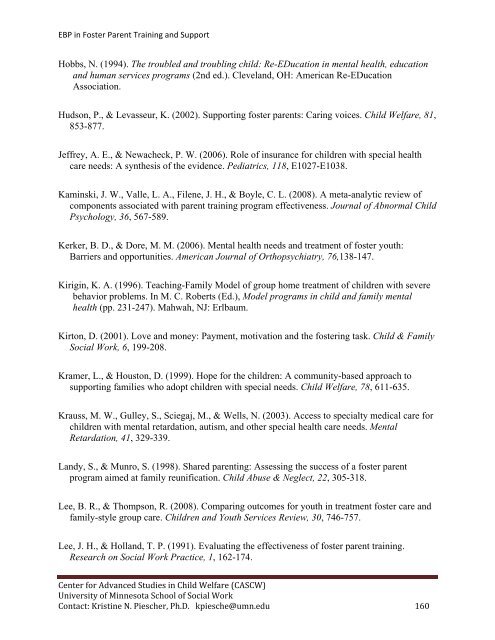Evidence-Based Practice in Foster Parent Training and Support ...
Evidence-Based Practice in Foster Parent Training and Support ...
Evidence-Based Practice in Foster Parent Training and Support ...
You also want an ePaper? Increase the reach of your titles
YUMPU automatically turns print PDFs into web optimized ePapers that Google loves.
EBP <strong>in</strong> <strong>Foster</strong> <strong>Parent</strong> Tra<strong>in</strong><strong>in</strong>g <strong>and</strong> <strong>Support</strong>Hobbs, N. (1994). The troubled <strong>and</strong> troubl<strong>in</strong>g child: Re-EDucation <strong>in</strong> mental health, education<strong>and</strong> human services programs (2nd ed.). Clevel<strong>and</strong>, OH: American Re-EDucationAssociation.Hudson, P., & Levasseur, K. (2002). <strong>Support</strong><strong>in</strong>g foster parents: Car<strong>in</strong>g voices. Child Welfare, 81,853-877.Jeffrey, A. E., & Newacheck, P. W. (2006). Role of <strong>in</strong>surance for children with special healthcare needs: A synthesis of the evidence. Pediatrics, 118, E1027-E1038.Kam<strong>in</strong>ski, J. W., Valle, L. A., Filene, J. H., & Boyle, C. L. (2008). A meta-analytic review ofcomponents associated with parent tra<strong>in</strong><strong>in</strong>g program effectiveness. Journal of Abnormal ChildPsychology, 36, 567-589.Kerker, B. D., & Dore, M. M. (2006). Mental health needs <strong>and</strong> treatment of foster youth:Barriers <strong>and</strong> opportunities. American Journal of Orthopsychiatry, 76,138-147.Kirig<strong>in</strong>, K. A. (1996). Teach<strong>in</strong>g-Family Model of group home treatment of children with severebehavior problems. In M. C. Roberts (Ed.), Model programs <strong>in</strong> child <strong>and</strong> family mentalhealth (pp. 231-247). Mahwah, NJ: Erlbaum.Kirton, D. (2001). Love <strong>and</strong> money: Payment, motivation <strong>and</strong> the foster<strong>in</strong>g task. Child & FamilySocial Work, 6, 199-208.Kramer, L., & Houston, D. (1999). Hope for the children: A community-based approach tosupport<strong>in</strong>g families who adopt children with special needs. Child Welfare, 78, 611-635.Krauss, M. W., Gulley, S., Sciegaj, M., & Wells, N. (2003). Access to specialty medical care forchildren with mental retardation, autism, <strong>and</strong> other special health care needs. MentalRetardation, 41, 329-339.L<strong>and</strong>y, S., & Munro, S. (1998). Shared parent<strong>in</strong>g: Assess<strong>in</strong>g the success of a foster parentprogram aimed at family reunification. Child Abuse & Neglect, 22, 305-318.Lee, B. R., & Thompson, R. (2008). Compar<strong>in</strong>g outcomes for youth <strong>in</strong> treatment foster care <strong>and</strong>family-style group care. Children <strong>and</strong> Youth Services Review, 30, 746-757.Lee, J. H., & Holl<strong>and</strong>, T. P. (1991). Evaluat<strong>in</strong>g the effectiveness of foster parent tra<strong>in</strong><strong>in</strong>g.Research on Social Work <strong>Practice</strong>, 1, 162-174.Center for Advanced Studies <strong>in</strong> Child Welfare (CASCW)University of M<strong>in</strong>nesota School of Social WorkContact: Krist<strong>in</strong>e N. Piescher, Ph.D. kpiesche@umn.edu 160
















